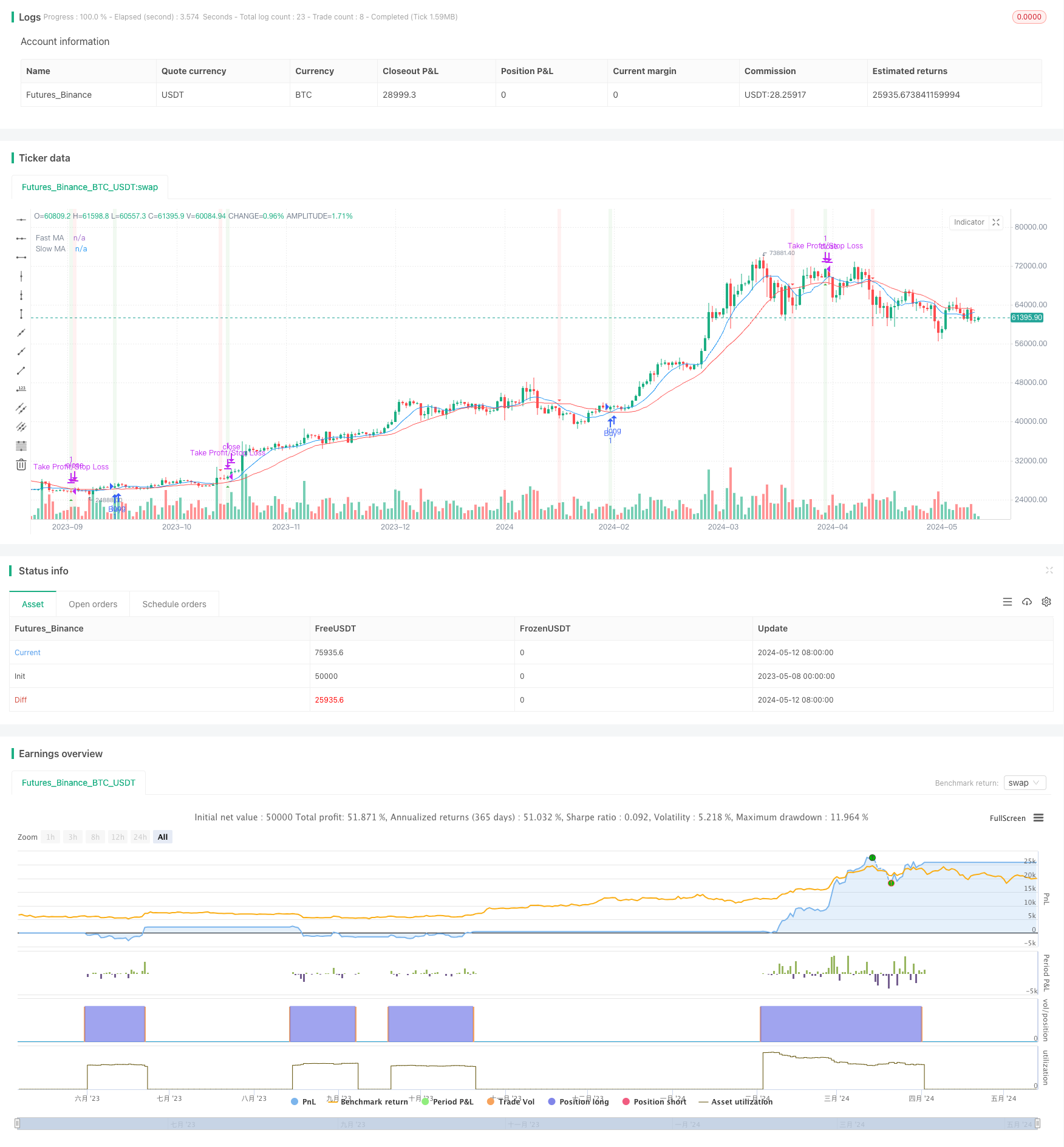
概述
该策略是一个基于两条简单移动平均线(SMA)交叉的交易策略。它计算一条快速移动平均线(默认9个周期)和一条慢速移动平均线(默认21个周期)。当快速移动平均线从下向上穿过慢速移动平均线时,产生买入信号;当快速移动平均线从上向下穿过慢速移动平均线时,产生卖出信号。该策略还包含止损和止盈功能,以百分比形式设置,帮助管理风险。此外,该策略可以在买卖信号产生时发出警报,使交易者可以及时采取行动。
策略原理
该策略的核心原理是利用两条不同周期的移动平均线之间的交叉关系来识别潜在的趋势变化。快速移动平均线对价格变化更敏感,而慢速移动平均线提供了更平滑的价格趋势表现。当快速移动平均线穿过慢速移动平均线时,表明价格趋势可能发生了变化。具体来说:
当快速移动平均线从下向上穿过慢速移动平均线时,表明上涨趋势可能正在形成,因此产生买入信号。
当快速移动平均线从上向下穿过慢速移动平均线时,表明下跌趋势可能正在形成,因此产生卖出信号。
通过结合止损和止盈,该策略旨在捕捉潜在的趋势变化,同时管理交易风险。
策略优势
简单易懂:该策略基于简单移动平均线,概念直观,易于理解和实施。
趋势识别:通过使用不同周期的移动平均线,该策略可以帮助识别潜在的趋势变化,为交易者提供买卖信号。
风险管理:内置的止损和止盈功能可以帮助交易者管理风险,限制潜在损失并锁定利润。
灵活性:交易者可以根据自己的偏好调整移动平均线的周期、止损和止盈百分比等参数。
警报功能:该策略可以在买卖信号产生时发出警报,使交易者可以及时采取行动。
策略风险
滞后性:移动平均线是一个滞后指标,它基于历史价格数据。在快速变化的市场条件下,信号可能延迟。
虚假信号:在某些情况下,快速移动平均线可能与慢速移动平均线产生多次虚假交叉,导致误导性的买卖信号。
趋势识别失败:该策略在震荡市场或缺乏明确趋势的市场条件下可能表现不佳。
参数敏感性:该策略的性能可能对移动平均线的周期选择敏感。不恰当的参数选择可能导致次优结果。
策略优化方向
参数优化:对移动平均线的周期、止损和止盈百分比等参数进行优化和回测,以找到最佳组合。
结合其他指标:将该策略与其他技术指标(如相对强弱指数、随机振荡器等)相结合,以确认趋势和改进信号。
动态止损和止盈:实施动态止损和止盈机制,例如基于平均真实范围(ATR)或支撑位/阻力位的止损和止盈。
风险管理改进:根据个人风险偏好和市场情况,调整每笔交易的风险百分比。考虑市场波动性的变化。
多时间框架分析:在不同的时间框架上分析该策略,以获得趋势和潜在买卖机会的更全面视角。
总结
该SMA双均线交易策略提供了一种简单而有效的方法,利用不同周期移动平均线的交叉来识别潜在的趋势变化并产生买卖信号。通过纳入止损和止盈以及警报功能,该策略旨在帮助交易者管理风险并及时采取行动。然而,交易者必须意识到该策略的局限性,如滞后性和虚假信号的可能性。通过优化参数、结合其他指标、实施动态风险管理措施以及在多个时间框架上进行分析,可以进一步改进该策略的性能。无论如何,在实际应用之前,全面了解该策略并根据个人风险偏好和市场情况进行调整是至关重要的。
/*backtest
start: 2023-05-08 00:00:00
end: 2024-05-13 00:00:00
period: 1d
basePeriod: 1h
exchanges: [{"eid":"Futures_Binance","currency":"BTC_USDT"}]
*/
//@version=5
strategy("Moving Average Crossover with Risk Management and Alerts", overlay=true)
// Input parameters
fast_length = input.int(9, title="Fast MA Length")
slow_length = input.int(21, title="Slow MA Length")
src = input(close, title="Source")
stop_loss_percent = input.float(1.0, title="Stop Loss (%)")
take_profit_percent = input.float(2.0, title="Take Profit (%)")
risk_per_trade_percent = input.float(2.0, title="Risk Per Trade (%)")
// Calculate moving averages
fast_ma = ta.sma(src, fast_length)
slow_ma = ta.sma(src, slow_length)
// Plot moving averages
plot(fast_ma, color=color.new(color.blue, 0), title="Fast MA")
plot(slow_ma, color=color.new(color.red, 0), title="Slow MA")
// Generate buy and sell signals
buy_signal = ta.crossover(fast_ma, slow_ma)
sell_signal = ta.crossunder(fast_ma, slow_ma)
// Plot buy and sell signals
plotshape(buy_signal, style=shape.triangleup, location=location.belowbar, color=color.new(color.green, 0), size=size.small, title="Buy Signal")
plotshape(sell_signal, style=shape.triangledown, location=location.abovebar, color=color.new(color.red, 0), size=size.small, title="Sell Signal")
// Calculate stop loss and take profit levels
stop_loss_level = strategy.position_avg_price * (1 - stop_loss_percent / 100)
take_profit_level = strategy.position_avg_price * (1 + take_profit_percent / 100)
// Risk management
if (buy_signal)
strategy.entry("Buy", strategy.long)
strategy.exit("Take Profit/Stop Loss", "Buy", stop=stop_loss_level, limit=take_profit_level)
// Alerts
alertcondition(buy_signal, title="Buy Signal", message="Buy Signal Detected!")
alertcondition(sell_signal, title="Sell Signal", message="Sell Signal Detected!")
// Visual enhancements
bgcolor(buy_signal ? color.new(color.green, 90) : na)
bgcolor(sell_signal ? color.new(color.red, 90) : na)